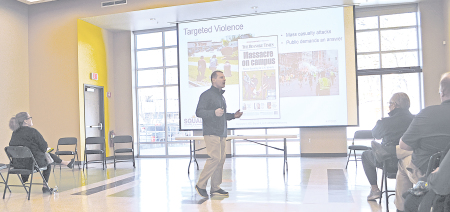Outdoor Chenango: Last Chances For The Regular Hunting Season
Published:
December 4th, 2024
By:
Eric Davis

This upcoming Sunday, December 8, is the final day of the regular firearms season for white-tailed deer here in the Southern Zone.
While there is the 8-day long muzzleloader/late archery season that follows this, not everyone partakes in this. So here are some tips for bagging a deer during the last week of the season.
Food becomes important as the rut finishes up and bucks need to feed heavily to build up their fat reserves for winter. Foods high in carbohydrates will attract deer, especially bucks.
Corn fields can have a fair amount of residual corn left from when it is harvested by farmers. If you were able to plant a food plot in the late summer with brassicas such as turnips or radishes, expect deer to start using the plot. With cold temperatures overnight, deer will start moving throughout the day as the urge to eat more calories outcompetes their sense of staying hidden. If you don’t have access to agriculture fields or hunt big woods, look for stands of oaks. Deer will dig through the snow and leaves to find acorns that have been sitting on the ground for a few months and have lost some of their tannins. With the snow cover we currently have, look for southern-facing fields that get hit with more sunlight (if the sun ever shows up). That bit of radiant heat will melt the snow a little bit and make it easier for the deer to get to the food on the ground.
One of the traditional ways of hunting deer is by doing drives. In a deer drive, some hunters are positioned as sitters or watchers while other hunters are the drivers and walk through the woods to spook deer into going towards the sitters. Driving deer can very productive, especially in areas with a lot of thick cover where deer can stay hidden from treestand hunters. Safety should always be the number one focus when doing drives. Know where each sitter is going to be located, and where the drivers will be coming from. Having everyone wear a blaze vest and hat makes them very visible to other hunters. Know what direction is a safe shot and what direction isn’t safe. When setting up the drive, make it so the wind is in the sitters’ faces so that the drivers are walking with the wind at their back so deer can wind the drivers but not the sitters. Keeping the drivers spaced out about 60 to 75 yards apart helps reduce the chances of deer doubling back by the drivers. If the drivers move at a slow pace, they can find themselves with possible shots instead of just seeing deer running away. Take three to five steps, then stop and count to five in your head. Repeat this through the entire drive. Not only does this give drivers potential shots, it also keeps the deer from running full speed and gives the sitters a better shot opportunity.
In areas with high enough doe populations, a “second rut” will start to show as does that did not get bred last month come back into estrus. It often occurs a month after peak rut, so this week should be it. The action won’t be crazy like in early November with bucks cruising all over the countryside, but a seasoned buck will know to be on the lookout for a late estrus doe. Hunting between bedding and feeding areas will give you a chance to catch any bucks coming through scent-checking for any last chance breeding opportunities. It might also be the time to use up any doe-in-heat urine you have left so you don’t have to try to store it until next fall.
Author: Eric Davis - More From This Author
Comments








